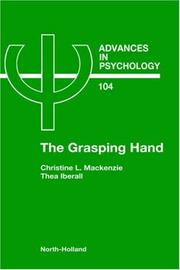| Listing 1 - 2 of 2 |
Sort by
|

ISBN: 1281793426 9786611793425 0080867588 0444817468 9780080867588 9781281793423 9780444817464 Year: 1994 Publisher: Amsterdam New York North-Holland
Abstract | Keywords | Export | Availability | Bookmark
 Loading...
Loading...Choose an application
- Reference Manager
- EndNote
- RefWorks (Direct export to RefWorks)
The simple task of grasping objects has been studied for centuries by scientists, therapists and engineers who have tried to understand and duplicate the versatility of the human hand. Using an interdisciplinary approach and new framework for looking at prehension, the authors uncover the subleties of the amazing interaction between the hand and the brain. They draw from such diverse fields as experimental psychology, kinesiology, robotics, neural networks, artificial intelligence, neuropsychology and rehabilitation. A triangle strategy is presented, starting from conceptual models that sugges
Hand --- Motor ability. --- Movements. --- Movements --- Computer simulation. --- Psychophysiology. --- Hands --- Paw --- Paws --- Arm --- Left- and right-handedness --- Agility --- Coordination, Muscular --- Dexterity --- Manual dexterity --- Manual skill --- Motor control (Physiology) --- Motor dexterity --- Motor skill --- Motor skills --- Muscular coordination --- Skills, Motor --- Ability --- Movement, Psychology of --- Kinesiology --- Mechanical ability

ISBN: 9780080867588 0080867588 1281793426 9781281793423 9786611793425 9780444817464 0444817468 Year: 1994 Publisher: Amsterdam ; New York : North-Holland,
Abstract | Keywords | Export | Availability | Bookmark
 Loading...
Loading...Choose an application
- Reference Manager
- EndNote
- RefWorks (Direct export to RefWorks)
The simple task of grasping objects has been studied for centuries by scientists, therapists and engineers who have tried to understand and duplicate the versatility of the human hand. Using an interdisciplinary approach and new framework for looking at prehension, the authors uncover the subleties of the amazing interaction between the hand and the brain. They draw from such diverse fields as experimental psychology, kinesiology, robotics, neural networks, artificial intelligence, neuropsychology and rehabilitation. A triangle strategy is presented, starting from conceptual models that sugges
Computer architecture. Operating systems --- Hand --- Motor ability. --- Movements. --- Movements --- Computer simulation. --- Psychophysiology.
| Listing 1 - 2 of 2 |
Sort by
|

 Search
Search Feedback
Feedback About UniCat
About UniCat  Help
Help News
News